For anyone looking for an e-commerce platform to sell their products or services, it’s important to find one equipped with all of the features necessary to host their site, manage their sales, and streamline their business processes.
For developers especially, the process of finding the right e-commerce platform to sell their development services can be a bit more involved, as they’ll likely want a more robust platform with full customization options and a bit more tech-savvy interface. After all, they’re experts in the web development space, so they’ll want to make sure they are also working with the best platforms out there to showcase their own work.
So, which e-commerce platforms offer the best features for developers? Read on to explore which sites are the best for developers looking to sell their services.
1. X-Cart
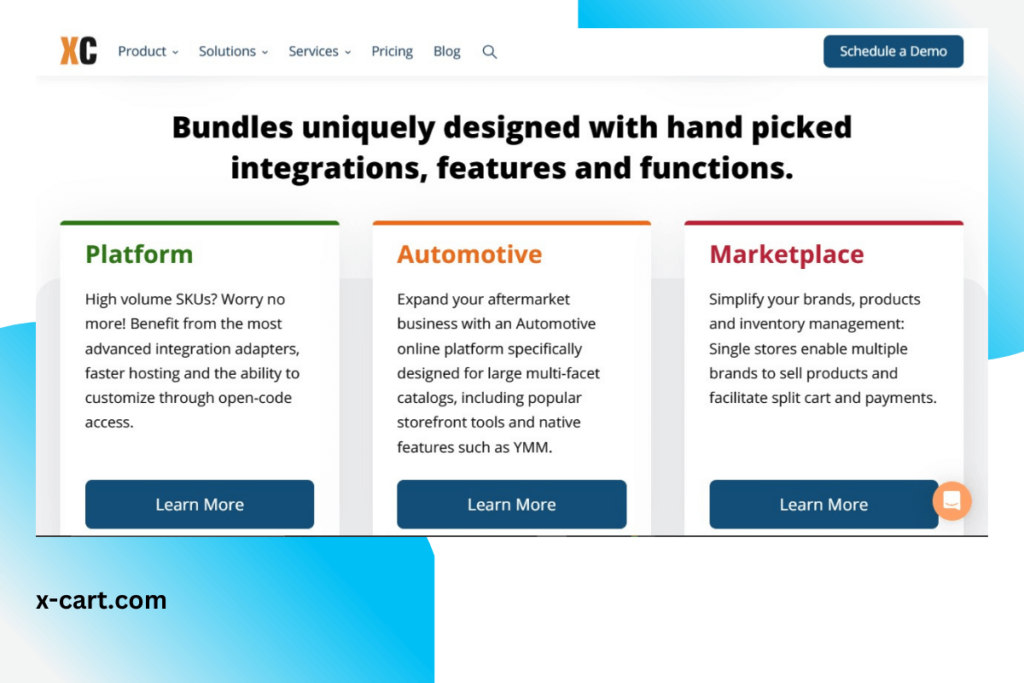
X-Cart coins itself “the last e-commerce platform you will ever need” and backs that up with top-tier features that make it appealing for developers looking to sell their services.
Why it’s great: X-Cart is an open-source platform, designed to allow its clients to design their storefront without limits or constraints. This is an especially great feature for developers, who likely have a very specific vision when it comes to the design of their site.
For those looking to get started quickly, there are ready-made extensions that can be used to get a jump-start on your launch. And for others looking to fully customize their digital storefronts from the ground up, a toolbox of full customization options and more than 1500 apps on the X-Cart marketplace make this a truly versatile platform.
How much does it cost? While X-Cart claims to be PCI compliant, you’ll still need to buy an SSL certificate to encrypt your site. SSLs can cost anything from $5 per month to $999 per year based on the provider.
2. Magento
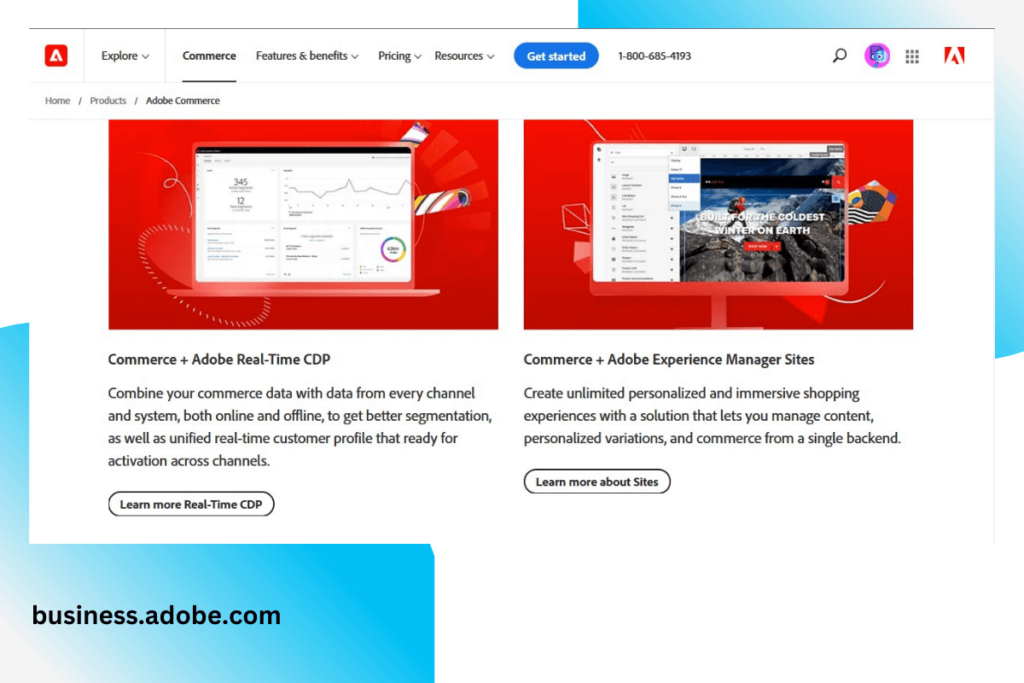
An open-source platform with more than a decade of success in the e-commerce space, Magento is backed by the tech industry experts at Adobe, making it a clear frontrunner for developers looking to build out their own sites and storefronts.
Why it’s great: For developers seeking the most control over their online shops, Magento is a solid choice. If you don’t have any Magento experience, you’ll need to hire someone who does, as it’s not a drag-and-drop builder like some of the more beginner-friendly platforms.
For developers though, this may be a highlight instead of a drawback, as it allows them to lean on their experience and build out their storefront with complete control. Other e-commerce highlights include built-in checkout, payment, and shipping modules, which must also be built out entirely.
Magento prioritizes SEO, making it easy for developers to get their services in front of expanded audiences. The platform is also backed by unlimited support from Adobe experts.
How much does it cost? Pricing varies greatly based on business needs.
3. PrestaShop
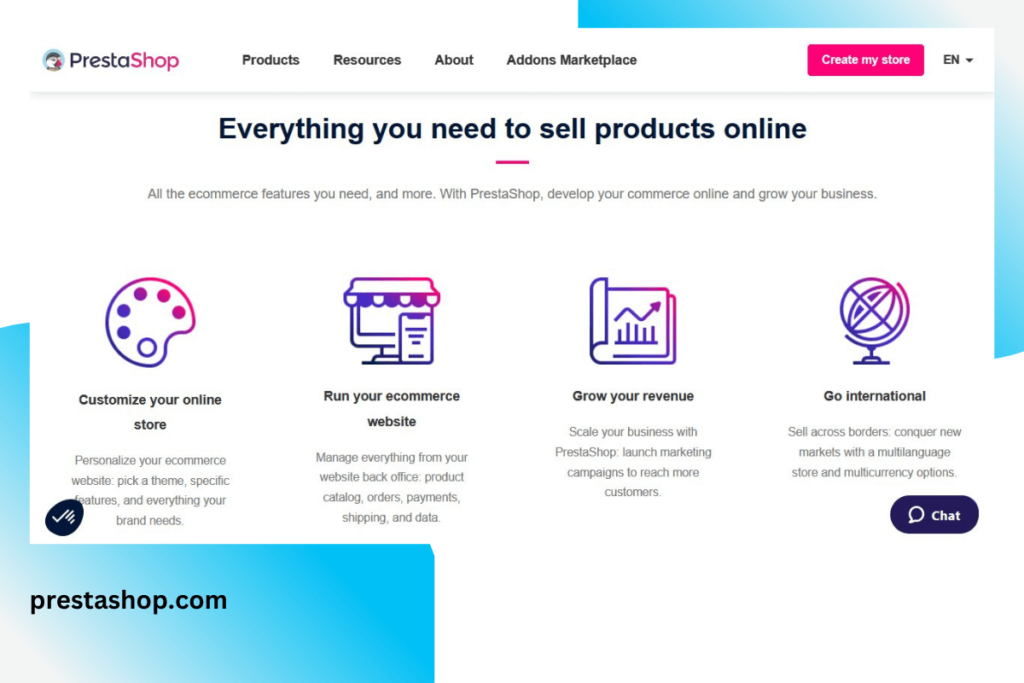
PrestaShop is a community-driven open-source e-commerce platform trusted by more than 300,000 merchants to run their online storefronts. Its focus on global scalability makes PrestaShop the platform of choice for many developers hoping to reach clients across the globe.
Why it’s great: For developers looking for global reach, PrestaShop’s availability in 75 different languages, along with its multiple payment options, make it a go-to platform. PrestaShop payment gateways can be built using a variety of integrations, including PayPal, Skrill, and the Blockonomics Bitcoin Payments add-on. PrestaShop’s platform also includes a free built-in fraud detection system for extra support and security.
For those looking to outsource work or customize the store front, PrestaShop’s marketplace offers additional add-ons and features including modules for live chat plugins, shipping options, marketing tools, reporting, and more.
How much does it cost? The basics of PrestaShop are free, but most themes, add-ons, and even advanced customer support require varying fees.
4. WooCommerce

WooCommerce is a free WordPress plugin that allows you to integrate e-commerce capabilities into existing WordPress sites.
Why it’s great: Many developers use WordPress to host their own sites as well as their clients’ sites. That’s why WooCommerce is a no-brainer for those in the development space, as it makes for seamless integration without the need to build out an additional storefront on an entirely new platform.
There are several free themes to choose from to get an e-commerce shop up and running, with the option to invest in premium themes for those hoping to build out a more unique shop with customized features. WooCommerce allows for easy integration of a variety of payment options, including major credit cards, Stripe, and PayPal.
How much does it cost? The WooCommerce plugin is free, but charges a small fee for each transaction.
5. OpenCart

OpenCart is a simple-to-use, open-source e-commerce platform, with over 342,000 businesses utilizing the platform for their online shops. OpenCart offers several built-in features as well as a large library of free extensions. Its massive list of built-in payment gateways makes it an excellent platform for developers with a global customer base.
Why it’s great: OpenCart’s flexibility makes it a great choice for developers and any business owners looking to add digital items to their storefronts. For both one-time and subscription sale methods, business owners can add an infinite number of physical or digital items. It’s also easy to use as a customer – by default, OpenCart gives you the choice of checking out as a visitor or as a registered user, so there’s no need to register on the site when making a one-time purchase.
OpenCart has 36 payment gateways built-in, which is a major selling point for businesses operating on a global scale. Payment options include Authorize.Net, Amazon Payments, First Data, Klarna, LiqPay, Skrill, PayPal, SagePay, and many others. OpenCart also works with Australia Post, Citylink, FedEx, Parcelforce, Royal Mail, UPS, and USPS to incorporate a wide range of shipping methods.
Brand management, customer management, order management, tax law, and promo codes are all simple to handle from the platform’s dashboard, which provides data and analytics to keep an eye on business processes.
How much does it cost? OpenCart is free, and also offers paid dedicated commercial support, which starts at $99 per month per domain.
6. Wix
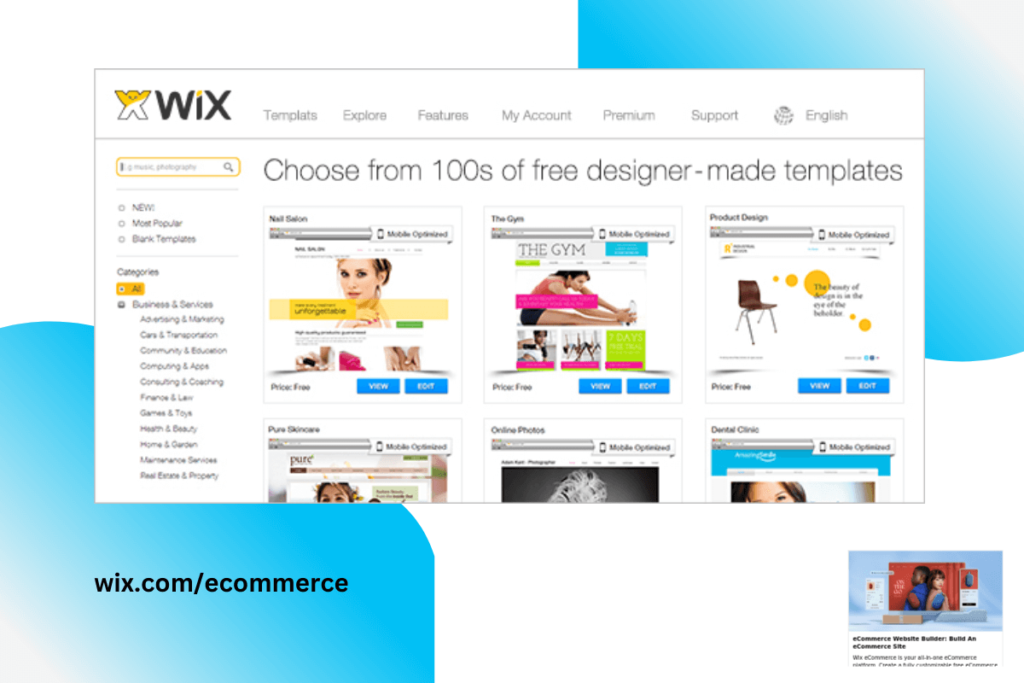
Wix is one of the most popular web-building and e-commerce platforms in the world, trusted by more than half a million businesses to house their online websites and storefronts. With more than 90+ languages and 500+ free mobile-optimized e-commerce themes, it’s a great platform for developers and businesses with global reach.
Why it’s great: Wix’s main goal is to make creating a website or an online store as simple as possible for developers. The easy drag-and-drop site build feature means no major coding, but storefronts can still be totally customized for a well-branded look.
E-commerce features include abandoned cart recovery, a customizable checkout screen, instant buy buttons, add to cart from a gallery, wish lists, rewards schemes, discount codes, and customer profiles.
Wix has payment integrations with more than 40 different companies, including PayPal, Stripe, and Square, as well as an in-house payment platform, Wix Payments.. Wix Payments, their in-house-built payment platform, allows you to accept credit/debit card payments and connect with other payment providers. Wix also supports Facebook, Instagram, and eBay for multi-channel sales.
Direct and drop shipping are both supported by Wix, and both can be managed from the dashboard. You can create custom shipping rates, create shipping rules, and print shipping labels. Wix’s agreement with USPS provides you with reduced shipping rates, which is a great benefit.
There are a lot of interesting reports on the analytics side as well. Google analytics, customized reports, top product reports, and market insights are all available through one dashboard. The availability of various statistics is determined by the subscription package you choose.
How much does it cost? Pricing for wix sites with e-commerce functionality starts at $23 per month.
7. Shopify
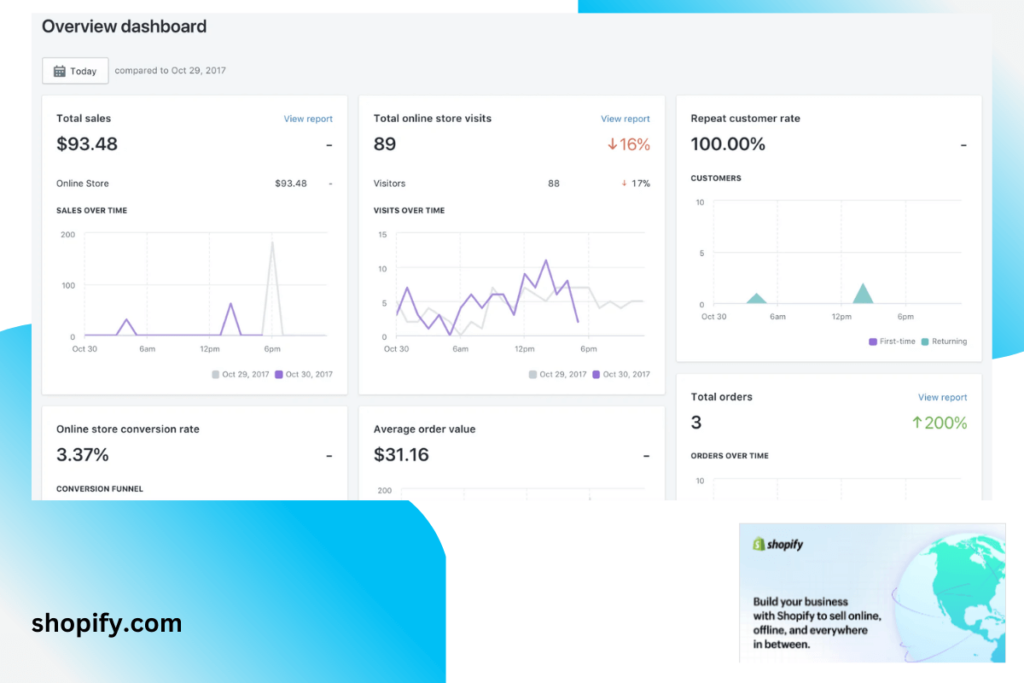
With over one million stores, 2.1 million active users, and $155 billion in sales, Shopify is a very well regarded e-commerce platform provider. You have the choice of using Shopify Payments, which was created in-house by Shopify.
Why it’s great: For business owners using Shopify to handle their e-commerce storefronts, Managing inventory and orders, as well as creating product pages, are simple and straightforward. You can drag and drop your items into their GUI, which includes automatic image optimization and the ability to buy additional plugins from Shopify’s App Store.
Shopify offers 73 mobile-optimized themes to choose from, including a selection of free templates as well as many options for premium designs. The number of items you can add is unlimited. To process subscription services, you’ll need a plugin app, which you can get from the Shopify App Store.
Abandoned cart recovery, gift cards, personalized discount codes, and advanced marketing tools like email marketing and social media distribution are some of the other notable features, which vary based on your location.
For those seeking help and advice on Shopify logistics, the platform offers 24/7 customer support. And for others looking to outsource work, Shopfiy’s marketplace of experts means developers can find partners or even sell their own services directly on the platform.
How much does it cost? Pricing begins at $29 per month.
8. Squarespace

Squarespace is a fantastic all-in-one platform for setting up a profitable online store. They handle all server management and provide you with simple tools for setting up and running your store – meaning developers can spend less time on their own storefronts, and more time focusing on developing sites for their customers.
Why it’s great: You’ll have access to a large number of mobile-friendly and customizable templates that you can further customize with CSS and Javascript. While you can upload as many physical items as you want, the subscription sale feature is only available with the Advanced Commerce package.
Highlights for e-commerce vendors include customizable advertising pop-ups and banners, abandoned cart recovery, automatic shipping rate estimates based on zip codes, customizable discount laws, custom API integration, and limited availability labels for promotional usage.
Squarespace lets you accept big credit card payments and have them deposited directly into your bank account. You may also build a Stripe account to accept additional payment methods like Apple Pay and PayPal. All of this enables you to embrace major currencies from all over the world in your online shop. With support for VAT, HST, and GST, you can also create custom tax rates. Taxes are also automatically reflected on invoices that can be customized.
Squarespace has a user-friendly GUI. From one central location, set up your product pages, manage your inventory, monitor any outstanding orders, and manage your customer base. A simple drag-and-drop tool makes it easy to update your customers via email and print packing slips.
To monitor the progress of your online shop, you get access to website analytics as well as additional sales and conversion metrics. You’ll also get a comprehensive view of your consumer base, including information on overall spending, average basket value, and other valuable statistics. Reports also provide valuable insight such as the best-selling items, latest market patterns, conversion tracking from a visit to a sale, and several other statistics can be found in the reports.
For any bumps in the road or questions, Squarespace offers 24/7 customer support.
How much does it cost? Pricing starts at $18 per month.
Finding the right e-commerce platform as a developer can be a tricky task. After all, in order to gain the trust of potential customers and clients, it’s essential to have an e-commerce storefront that’s professional, well-branded, and designed with the customer experience in mind.
For those looking for the right e-commerce platform for developers, some of the best options allow for highly-customized storefronts and a wide variety of payment gateways and languages. By doing the proper research and identifying which platforms have the most appealing features, developers can surely find the best e-commerce platforms for their businesses.
